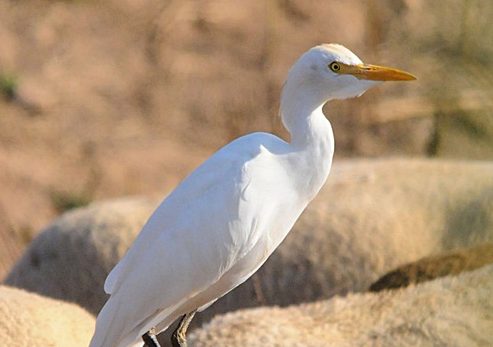WHAT’S THAT IN THE CLOT?
Anyone wandering in or around the Clot at sunset this winter cannot fail to have noticed flocks of large white birds flying into the main pool. You’d think they were flying in there to spend the night, and you’d be quite right – up to 100 of these birds congregate for safety in the reeds – even though the reedbed roost capacity has been somewhat reduced recently due to the much-needed clearance operations of the Clot authorities.
 These white birds are mostly Cattle Egrets, and this is a species which can be considered one of the most successful colonists in the world, having spread from its origins in Africa, Asia and here in the Iberian Peninsula to all seven continents. This is one of those birds whose name really does do what it says on the tin. Having evolved to feed alongside elephants and buffaloes on the African savannah, the cattle egret has been quick to transfer its loyalties to domestic breeds, and will happily root around for insects among herds of cows, sheep and goats.
These white birds are mostly Cattle Egrets, and this is a species which can be considered one of the most successful colonists in the world, having spread from its origins in Africa, Asia and here in the Iberian Peninsula to all seven continents. This is one of those birds whose name really does do what it says on the tin. Having evolved to feed alongside elephants and buffaloes on the African savannah, the cattle egret has been quick to transfer its loyalties to domestic breeds, and will happily root around for insects among herds of cows, sheep and goats.
Although it may appear at first glance to be an all-white bird, on closer examination you will see that there are faint orange patches on some birds, and these will deepen as we approach the breeding season – you can just make out an orange patch on the head of the one in my picture, which was actually standing on the back of a goat at the time! Also note the yellow dagger-shaped bill, which helps to separate this bird from the similar Little Egret which is also found in the Clot in smaller numbers, but which has a darker bill, a more slender appearance and no hint of orange about its person.
When they are not roosting in the Clot, they spread far and wide across agricultural land around our area, and are a common sight as you drive through the countryside. If a local farmer is ploughing a field, his tractor will be accompanied by a crowd of Cattle Egrets feeding off worms and insects disturbed by the plough, in much the same way that seagulls do back in the UK.
This bird was quite unknown in Britain until recent years, the first confirmed breeding took place back in 2008, and at the time of writing reports indicate that up to 1000 individuals may now be present, and like its cousin the Little Egret, is set fair to become a common sight back at home. Whether this is down to global warming or just the natural propensity of the species to spread far and wide, it just confirms the adaptability of this successful bird.
You can see more photographs of birds from our area by visiting www.marketheridge.smugmug.com
See you next month.
Mark



